

Blogs. 10 Cloud Tools You Should Know. Format policy registry requirements - Archivematica. Documentation > Requirements > Format policy registry requirements [edit] Overview The Archivematica project team is working on a better way to manage normalization format policies.A format policy consists of the business rules and tool commands for format normalization.The FPR lists all of Archivematica's default format policy rules.In your Archivematica 0.10-beta instance you can download updates from the FPR as well as replace default rules with your own local policies.Upcoming FPR enhancements will include statistical information about the default and custom format policies implemented by Archivematica users.
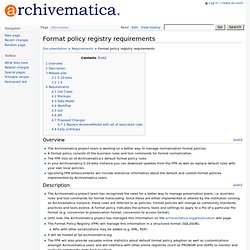
[edit] Description The Archivematica project team has recognized the need for a better way to manage preservation plans, i.e. business rules and tool commands for format transcoding. Since these are either implemented or altered by the institution running an Archivematica instance, these rules are referred to as policies. [edit] 0.10-beta [edit] 1.0 [edit] Use Cases [edit] Mockups. Publications. Current publications: Annual Reports provide an annual overview of the DPC community.
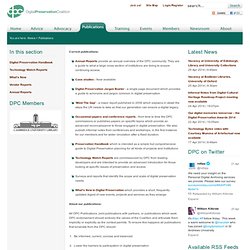
They are a guide to what a large cross section of institutions are doing to ensure continuing access.Case studies - Now availableDigital Preservation Jargon Buster - a single page document which provides a guide to acronyms and jargon common in digital preservation'Mind The Gap' - a major report published in 2006 which explains in detail the steps the UK needs to take so that our generation can ensure a digital legacyOccasional papers and conference reports - from time to time the DPC commissions or publishes papers on specific topics which provide an advanced reconnaissance to those engaged in digital preservation. About our publications: All DPC Publications, joint publications with partners, or publications which seek DPC endorsement should embody the values of the Coalition and articulate them implicitly or explicitly as the context permits.
DCC&U: An Extended Digital Curation Lifecycle Model. DCC&U: An Extended Digital Curation Lifecycle Model Panos Constantopoulos, Costis Dallas, Ion Androutsopoulos, Stavros Angelis, Antonios Deligiannakis, Dimitris Gavrilis, Yannis Kotidis, Christos Papatheodorou 2009, Vol. 4, No. 1, pp. 34-45 doi:10.2218/ijdc.v4i1.76 Abstract The proliferation of Web, database and social networking technologies has enabled us to produce, publish and exchange digital assets at an enormous rate.
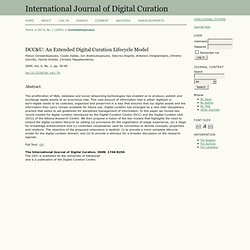
Full Text: PDF. Top 10 Digital Preservation Presentations of 2012 » Agogified. National Library of Australia Staff Papers. Digital Curation Resource Guide. DCC Curation Lifecycle Model. The model enables granular functionality to be mapped against it: to define roles and responsibilities and build a framework of standards and technologies to implement.
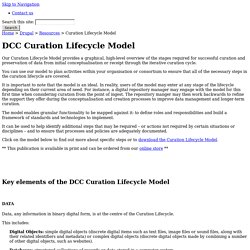
It can be used to help identify additional steps that may be required – or actions not required by certain situations or disciplines – and to ensure that processes and policies are adequately documented. Click on the model below to find out more about specific steps or to download the Curation Lifecycle Model. ** This publication is available in print and can be ordered from our online store ** Key elements of the DCC Curation Lifecycle Model Data, any information in binary digital form, is at the centre of the Curation Lifecycle. This includes: Databases: structured collections of records or data stored in a computer system. Preservation Planning Plan for preservation throughout the curation lifecycle of digital material.
Conceptualise Conceive and plan the creation of data, including capture method and storage options. Archival Metadata. Wendy Duff & Marlene van Ballegooie, University of Toronto Published: May 2006 Archivists and records managers have always been metadata experts.
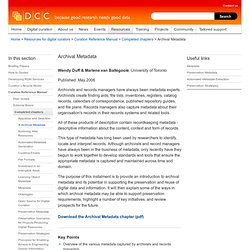
Archivists create finding aids, file lists, inventories, registers, catalog records, calendars of correspondence, published repository guides, and file plans. Records managers also capture metadata about their organisation's records in their records systems and related tools. All of these products of description contain recordkeeping metadata - descriptive information about the content, context and form of records. Dave Pearson The Adventures of Digi. LoC-Preservation National Heritage Report. In the Digital Era, Publication Isn’t Preservation. Publication used to mean preservation but it no longer does.
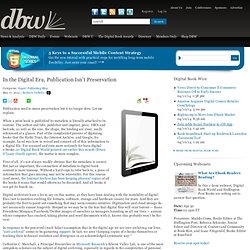
Let me explain. When a print book is published its metadata is literally attached to its content. The author and title, publisher and imprint, price, ISBN and barcode, as well as the size, the shape, the binding are clear, easily referenced at a glance. Part of the complicated process of digitizing books that the Hathi Trust, the Internet Archive, and Google, for example, faced was how to record and connect all of this information to a digital file. For scanned and even more seriously for born-digital e-books, as Digital Book World pointed out earlier this month (Brian O’Leary clearly agrees), the matter is more complex.
First of all, it’s not always readily obvious that the metadata is correct. Digital archivists have a lot to say on this matter, as they have been dealing with the instability of digital files (not to mention evolving file formats, software, storage and hardware issues) for years. Catherine C. Related Posts: Restaurator - StabilitiesOpticalDiscs.